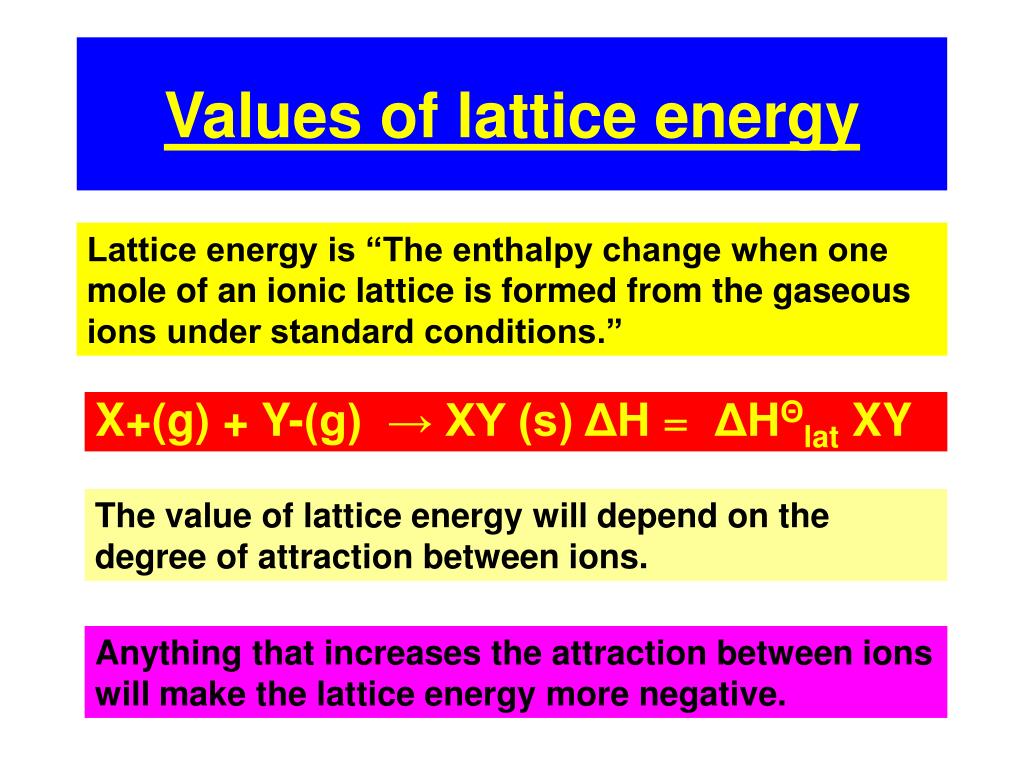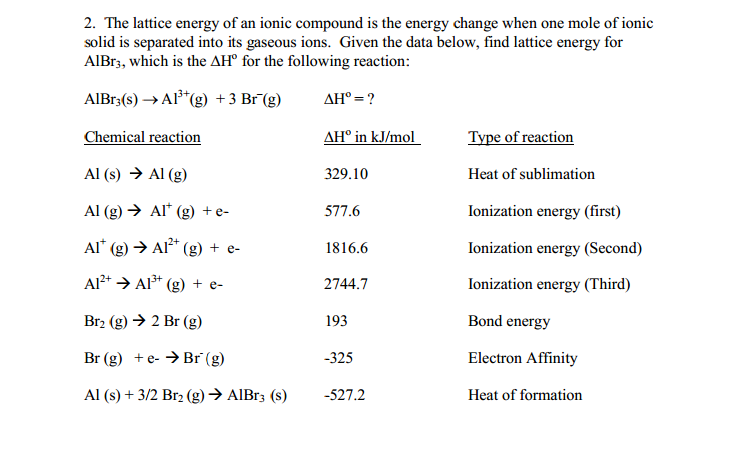
Ground State structures before and after relaxation and their energies are provided in the supporting information. The energies are corrected for the zero point energy (ZPE) and heat capacity and are reported for 298 K.
#LATTICE ENERGY EQUATION KE FULL#
For calculation of the thermodynamic properties like the enthalpy of formation, phonon calculations were performed for the full Brillouin zone on the relaxed structures. The k-mesh in the Brillouin zone was set as 3×3×3 and it was centered at the Γ-point. The energy cutoff for the plane waves was set to 500 eV. During the relaxation of the structure, no restrictions were imposed on the symmetry of the cell, volume of the cell or the position of atoms inside the cell. 22 These structures were then relaxed using the conjugated gradient (CG) method, with force tolerance of 0.02 eV Å -1. 21 The initial input structure for all the alkali halides were obtained from the Inorganic Crystal Structure Database (ICSD). 18 However, since GGA is well-known to underestimate the band gap in materials due to lack of proper localization of holes and electrons, few test calculations have also been performed through hybrid functionals like HSE06, 19 PBE0 20 and B3LYP. The calculations were performed within the General-Gradient Approximation (GGA), and the Perdew-Burke-Ernzerhof (PBE) prescription for the exchange-correlation functional. 17 The projected augmented wave (PAW) method is chosen to represent the ionic potentials. Also, a first principles calculation is further desirable to be able to calculate n without necessarily depending on experimental compressibility data, particularly for new ionic materials for which good experimental data might be unavailable or difficult to obtain.Īll the calculations reported in this manuscript are obtained using the Vienna ab initio simulation package, VASP which is plane wave based DFT code. Hence, it is important to be able to calculate the Born exponent, n with much higher accuracy that accounts for processes like CT as well as electron correlations. 14 Such, simple arithmetic mean does not consider other important factors like charge transfer (CT). 16 Thus, for ionic solids one needs to rely on the Born exponent of the cation and the anion and then average them for the compound. In principle, the Born exponents can be derived from the polarizability of atoms in a particular electronic configuration 15 or from the compressibility data. 15 Nevertheless, the exact values for either n or ρ remain mere parameters, something which is undesirable in molecular quantum chemistry. 14 Also, previous reports have indicated that an e -r/ρ form (Born-Mayer exponential law) describes the repulsive interactions more accurately. The 1/r n dependence of the repulsive interaction is well – known in the literature as Born relationship and n is known as the Born exponent. In either case, one empirically determines the parameters: n and ρ. Hence, one relies on empirical functional forms like (1/r n) or (e -r/ρ) to describe their behavior. Unfortunately, the spacial profile (variation with respect to the interatomic/interionic distance, r) of the repulsive interaction is unknown analytically.


This repulsive interaction primarily arises due to electron – electron repulsion between two closed shell atoms. However, for the stability of a crystal, apart from the attractive Coulomb forces, short range repulsive interactions are required to prevent the collapse of the structure to a point. 11,12 Hence, this problem is generally tackled numerically in computational chemistry through the Ewald's summation technique that gives excellent convergence with increase in the size/periodicity of the system.
#LATTICE ENERGY EQUATION KE SERIES#
Series summation method for the calculation of Madelung constant (M) for simple crystals is imprecise since such series are only conditionally convergent though numerically reasonable convergence is attainable. 9,10 Even within the point charge model, the number of ions in the crystal being of the order of N A (Avogadro's number), a proper summation of all charges across the lattice is an involved task.

This apparent simplicity is deceptive because Coulomb potential is a slowly decaying function and hence contributions from higher order multipole interactions need to be taken into consideration. Hence, the description of their ground state energies (and thus the structure, following the variation theorem) is exact within the point charge model. From an atomistic picture, ionic crystals are probably the simplest system to understand since the interactions among the ions are purely electrostatic in origin.


 0 kommentar(er)
0 kommentar(er)
